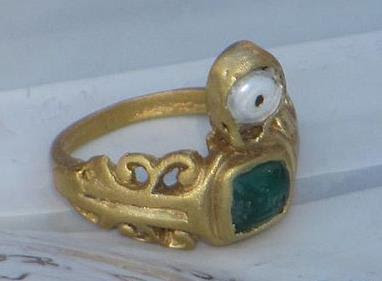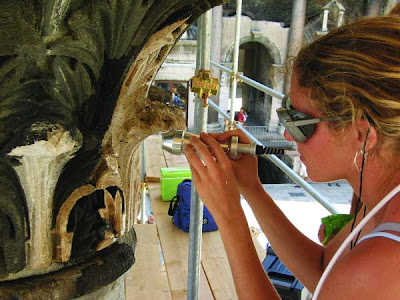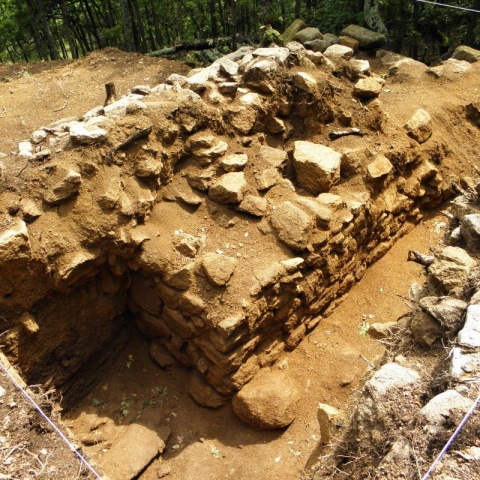The Roman Archaeology Blog is concerned with news reports featuring Roman period archaeology. If you wish to see news reports for general European archaeology, please go to The Archaeology of Europe Weblog.
Friday, August 16, 2013
Oxford Experience 2014
The programme for the Oxford Experience Summer School is now online. Registration will not begin until late September, but now is the time to start planning your courses for next summer.
You can find the programme here...
Roman temple clues found during dig in Conwy Valley
The site of the dig at Llwydfaen Farm where the Roman temple was found
The remains of what is suspected to be a Roman temple have uncovered by archaeologists who had been searching for a lost 11th Century church.
Archaeologists had been trying to find a Norman church on farmland in the Conwy Valley after baked remains became apparent during the hot summer of 2006.
But as the dig got under way the team realised there was a much older building on the site.
Researchers are trying to establish if it was a temple used by Roman soldiers.
The dig, which was being filmed for a Welsh-language television series, had been to try and uncover the remains of a church but instead artefacts dating back to Roman times were unearthed.
Read the rest of this article...
Late Roman ring to ward-off 'evil eye' found in Croatia
Archaeologists in Croatia have found an interesting ring from the 3rd century. At the depth of two metres in the soil in eastern town of Vinkovci they have found the ring with an "eye" that was, according to experts, used to protect the holder from spells.
 |
| The ring's "eye" protected the holder from spells [Credit: Croatian Times] |
"The ring has a drawn rabbit that tastes a flower and that was seen as a symbol of happiness, while the "eye" represents protection against disasters and spells", Vinkovci City Museum director Hrvoje Vulic has told to local news website Cibalia.info.
Read the rest of this article...
Thursday, August 15, 2013
ANALYSIS OF ANCIENT GLASS BEADS FROM CULT SITE IN GERMANY
The raw materials for ancient glass beads found in former Rhaetian settlements in Bavaria clearly did not originate from this region. This is the conclusion following an analysis of the beads at the TRIGA research reactor of the Institute of Nuclear Chemistry at Johannes Gutenberg University Mainz (JGU).
A total of 42 glass beads from four different sites were examined, 38 of them dating to the early Roman imperial period (30-60 A.D.) and four from the late Roman period (4th century A.D.). “We were able to clearly demonstrate that all of the glass beads from the four sites are made of soda-lime glass,” stated Barbara Karches of the JGU Institute of Nuclear Chemistry. The use of sodium to manufacture the glass indicates that the raw glass must have been produced in the vicinity of soda lakes. The investigations have also provided important information for historians on industry and technology, trade routes, and the lifestyle of people at that time.
Read the rest of this article...
Mini-Colosseum of 'Gladiator' Emperor Found
The Roman emperor Commodus might have cultivated the skills showcased in Ridley Scott’s blockbuster film “Gladiator” in a personal miniature Colosseum on his estate near Rome.
Archaeologists from Montclair State University, in New Jersey, believe that a large oval area with curved walls and floors made of marble is, in fact, the arena where the emperor killed wild beasts, earning the nickname “the Roman Hercules,” as recorded in historical writings.
Found in Genzano, a village southeast of Rome which overlooks Lake Nemi, a crater lake in the Alban Hills, the oval structure measures 200 feet by 130 feet and dates to the 2nd century.
It was found by the U.S. team as they excavated thermal baths at an estate known as the Villa of Antonines.
Read the rest of this article...
Monday, August 12, 2013
Hot summer unearths Roman discoveries in Wales
A tip-off from Dr Jeffrey Davies studying coin finds in central Wales led to this discovery of a previously unrecorded Roman fort complex
A rare Roman fort and marching camp have been discovered in Wales by aerial archaeologists during the hot summer.
The major Roman fort complex was spotted on parched grassland near Brecon, Powys, and the marching camp near Caerwent in Monmouthshire.
Aerial archaeologist Toby Driver said he could not believe his eyes when he spotted the fort from the air.
Scores of Iron Age farms and forts were also found in Pembrokeshire and the Vale of Glamorgan.
The crop of summer discoveries follow similarly exciting Bronze Age ones made during last winter's snow.
Read the rest of this article...
Tuesday, August 6, 2013
Bulgarian Archeologists Uncover Large Votive Relief of Zeus
A team of Bulgarian archeologists led by Dr. Ivan Hristov has discovered an unusually large votive relief of the ancient Greek God Zeus near the Bulgarian village of Starosel.
The news was announced by the National History Museum for the Bulgarian News Agency Focus.
The archeological team uncovered the votive relief which was much bigger than the ordinary ones and thus it was allegedly the center part of an ancient temple.
A large rock eagle appeared flying round when the archeological team was about to uncover the artifact. As the ancient Greek god Zeus was commonly featured as a rock eagle, some of the archeologists jokingly concluded that god Zeus should have come to look over his sanctuary.
Read the rest of this article...
Thursday, August 1, 2013
Roman skeletons discovered in Gloucester
The discovery has been called one of the most significant in recent years
About 40 skeletons have been uncovered by archaeologists at the site of a Roman cemetery in Gloucester.
The discovery was made during a dig at the former Gloscat site at Greyfriars in Brunswick Road, ahead of a housing development being built.
It has been described as one of the most significant archaeological finds in the city in the past 30 years.
The skeletons could end up in the care of Gloucester museum after scientific tests have been carried out.
Read the rest of this article...
Diocletian’s palace gets laser facelift
Conservators in Croatia have completed a ten-year project to remove more than 1,700 years of grime from the courtyard of the palace of the Roman Emperor Diocletian (AD244-311), in the coastal city of Split. Lasers were used as the primary method to clean the peristyle of the fourth-century imperial residence—an innovative technique that is normally reserved for cleaning individual sculptures or details of larger architectural elements, as opposed to whole structures. According to the architect Goran Niksic, who works for the city, this is the first time lasers have been used on this scale in Croatia to clean stone.
 |
| Emperor Diocletian’s palace in Split, Croatia underwent treatment by laser during the ten-year project [Credit:Art Newspaper] |
Read the rest of this article...
Subscribe to:
Posts (Atom)






